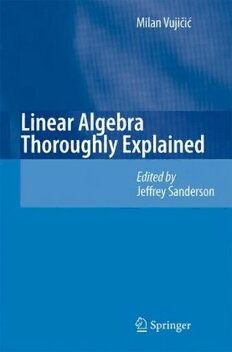Table Of ContentLinear Algebra Thoroughly Explained
Milan Vujicˇic´
Linear Algebra Thoroughly
Explained
Author Editor
MilanVujicˇic´ JeffreySanderson
(1931–2005) EmeritusProfessor,
SchoolofMathematics&Statistics,
UniversityofStAndrews,
StAndrews,
Scotland
ISBN:978-3-540-74637-9 e-ISBN:978-3-540-74639-3
LibraryofCongressControlNumber:2007936399
(cid:2)c 2008Springer-VerlagBerlinHeidelberg
Thisworkissubjecttocopyright. Allrightsarereserved,whetherthewholeorpartofthematerial is
concerned,specificallytherightsoftranslation,reprinting,reuseofillustrations,recitation,broadcasting,
reproductiononmicrofilmorinanyotherway,andstorageindatabanks.Duplicationofthispublication
orpartsthereofispermittedonlyundertheprovisionsoftheGermanCopyright LawofSeptember9,
1965,initscurrentversion,andpermissionforusemustalwaysbeobtainedfromSpringer.Violationsare
liabletoprosecutionundertheGermanCopyrightLaw.
Theuseofgeneraldescriptivenames,registerednames,trademarks,etc.inthispublicationdoesnotimply,
evenintheabsenceofaspecificstatement,thatsuchnamesareexemptfromtherelevantprotectivelaws
andregulationsandthereforefreeforgeneraluse.
CoverDesign:eStudioCalamarS.L.
Printedonacid-freepaper
9 8 7 6 5 4 3 2 1
springer.com
Foreword
Thereareazillionbooksonlinearalgebra,yetthisonefindsitsownuniqueplace
among them. It starts as an introduction at undergraduatelevel, covers the essen-
tial results at postgraduatelevel and reachesthe full power of the linear algebraic
methodsneededbyresearchers,especiallythoseinvariousfieldsofcontemporary
theoreticalphysics,appliedmathematicsandengineering.Atfirstsight,thetitleof
thebookmayseemsomewhatpretentiousbutitfaithfullyreflectsitsobjectiveand,
indeed,itsachievements.
MilanVujicˇic´startedhisscientificcarrierintheoreticalnuclearphysicsinwhich
he relied heavily in his research problemson linear algebraic and group theoretic
methods. Subsequently,he movedto the field of grouptheory itself and its appli-
cationsinvarioustopicsinphysics.Inparticular,heachieved,togetherwithFedor
Herbut,importantresultsinthefoundationsofanddistantcorrelationsinquantum
mechanics, where his understandingand skill in linear algebra was precedent.He
wasknownasanacuteandlearnedmathematicalphysicist.
AtfirstVujicˇic´ taughtgrouptheoryatgraduatelevel.However,histeachingca-
reerblossomedwhenhemovedtothePhysicsFacultyoftheUniversityofBelgrade,
anditcontinued,evenafterretirement,attheUniversityofMalta,wherehetaught
linearalgebraatthemostbasicleveltoteachingdiplomastudents.Hecontinuously
interestedhimselfintheproblemsofteaching,andwithworthyresults.Indeed,his
didactic works were outstanding and he was frequently singled out by students,
in their teaching evaluation questionnaires, as a superb teacher of mathematical
physics.
ThisbookisbasedonlecturesthatVujicˇic´ gavetobothundergraduateandpost-
graduate students over a period of several decades. Its guiding principle is to de-
velopthesubjectrigorouslybuteconomically,withminimalprerequisitesandwith
plentyofgeometricintuition.Thebookoffersapracticalsystemofstudieswithan
abundanceofworkedexamplescoordinatedinsuchawayastopermitthediligent
studenttoprogresscontinuouslyfromthefirsteasylessonstoarealmasteryofthe
subject.Throughoutthisbook,theauthorhassucceededinmaintainingrigourwhile
givingthereaderanintuitiveunderstandingofthesubject.Hehasimbuedthebook
with the same good sense and helpfulness that characterized his teaching during
v
vi Foreword
hislifetime.Sadly,havingjustcompletedthebook,MilanVujicˇic´ suddenlydiedin
December2005.
HavingknownMilanwell,asmythesisadvisor,acolleagueandadearfriend,I
amcertainthathewouldwishthisbooktobededicatedtohiswifeRadmilaandhis
sonsBorisandAndrejfortheirpatience,supportandlove.
Belgrade,July2007 DjordjeSˇijacˇki,
Acknowledgements
ThanksareduetoseveralpeoplewhohavehelpedinvariouswaystobringProfessor
Vujicˇic´’s manuscript to publication. Vladislav Pavlovicˇ producedthe initial Latex
copy,andsubsequently,Dr.PatriciaHeggieprovidedtimelyandinvaluabletechni-
calhelpinthisarea.ProfessorsJohnCornwellandNikolaRuskucoftheUniversity
of St. Andrewsread andmade helpfulcommentsuponthe manuscriptin the light
of which Professor Milan Damnjanovicˇ of the University of Belgrade made some
amendments.Finally,itisapleasuretothankProfessorDjordjeSˇijacˇkioftheUni-
versityofBelgradeandtheSerbianAcademyofSciencesforwritingtheForeword.
vii
Contents
1 VectorSpaces.................................................. 1
1.1 Introduction ............................................... 1
1.2 GeometricalVectorsinaPlane ............................... 2
1.3 VectorsinaCartesian(Analytic)PlaneR2...................... 5
1.4 ScalarMultiplication(TheProductofaNumberwithaVector) .... 7
1.5 TheDotProductofTwoVectors(ortheEuclideanInnerProduct
ofTwoVectorsinR2)....................................... 8
1.6 ApplicationsoftheDotProductandScalarMultiplication ........ 10
1.7 VectorsinThree-DimensionalSpace(SpatialVectors)............ 15
1.8 TheCrossProductinR3..................................... 18
1.9 The Mixed Triple Productin R3. Applicationsof the Cross
andMixedProducts ........................................ 21
1.10 EquationsofLinesinThree-DimensionalSpace................. 24
1.11 EquationsofPlanesinThree-DimensionalSpace ................ 26
1.12 RealVectorSpacesandSubspaces ............................ 28
1.13 LinearDependenceandIndependence.SpanningSubsetsandBases 30
1.14 TheThreeMostImportantExamplesofFinite-DimensionalReal
VectorSpaces.............................................. 33
1.14.1 TheVectorSpaceRn(NumberColumns) ................ 33
1.14.2 TheVectorSpaceRn×n(Matrices)...................... 35
1.14.3 TheVectorSpaceP (Polynomials) ..................... 37
3
1.15 SomeSpecialTopicsaboutMatrices........................... 39
1.15.1 MatrixMultiplication................................. 39
1.15.2 SomeSpecialMatrices................................ 40
A Determinants.................................................. 45
A.1 DefinitionsofDeterminants.................................. 45
A.2 PropertiesofDeterminants................................... 49
ix
x Contents
2 LinearMappingsandLinearSystems ............................ 59
2.1 AShortPlanfortheFirst5SectionsofChapter2................ 59
2.2 SomeGeneralStatementsaboutMapping ...................... 60
2.3 TheDefinitionofLinearMappings(Linmaps) .................. 62
2.4 TheKernelandtheRangeofL ............................... 63
2.5 TheQuotientSpaceV /kerLandtheIsomorphismV /ker ∼=L(cid:2) ran L 65
n n
2.6 RepresentationTheory ...................................... 67
2.6.1 TheVectorSpaceLˆ(V ,W ) ........................... 68
n m
2.6.2 TheLinearMapM:Rn→Rm ......................... 69
2.6.3 TheThreeIsomorphismsv, wandv−w ................. 70
2.6.4 HowtoCalculatetheRepresentingMatrixM............. 72
2.7 AnExample(RepresentationofaLinmapWhichActsbetween
VectorSpacesofPolynomials) ............................... 75
2.8 SystemsofLinearEquations(LinearSystems) .................. 79
2.9 TheFourTasks ............................................ 85
2.10 TheColumnSpaceandtheRowSpace ........................ 86
2.11 Two Examples of Linear Dependence of Columns
andRowsofaMatrix ....................................... 88
2.12 ElementaryRowOperations(Eros)andElementaryMatrices...... 91
2.12.1 Eros ............................................... 91
2.12.2 ElementaryMatrices ................................. 93
2.13 TheGJFormofaMatrix .................................... 95
2.14 An Example (Preservation of Linear Independence
andDependenceinGJForm)................................. 97
2.15 The Existence of the Reduced Row-Echelon (GJ)
FormforEveryMatrix ...................................... 99
2.16 TheStandardMethodforSolvingAX¯ =b¯ .....................101
2.16.1 When Does a Consistent System AX¯ =b¯ Have
aUniqueSolution?...................................102
2.16.2 WhenaConsistentSystemAX¯ =b¯ HasNo
UniqueSolution .....................................108
2.17 TheGJMProcedure–aNewApproachtoSolvingLinearSystems
withNonuniqueSolutions ...................................109
2.17.1 DetailedExplanation .................................110
2.18 SummaryofMethodsforSolvingSystemsofLinearEquations....116
3 Inner-ProductVectorSpaces(EuclideanandUnitarySpaces) .......119
3.1 EuclideanSpacesE ........................................119
n
3.2 UnitarySpacesU (orComplexInner-productVectorSpaces) .....126
n
3.3 Orthonormal Bases and the Gram-Schmidt Procedure
forOrthonormalizationofBases ..............................131
3.4 DirectandOrthogonalSumsofSubspacesandtheOrthogonal
ComplementofaSubspace ..................................139
3.4.1 DirectandOrthogonalSumsofSubspaces ...............139
3.4.2 TheOrthogonalComplementofaSubspace..............141
Contents xi
4 DualSpacesandtheChangeofBasis .............................145
∗
4.1 TheDualSpaceU ofaUnitarySpaceU ......................145
n n
4.2 TheAdjointOperator .......................................153
4.3 TheChangeofBasesinV (F)................................157
n
4.3.1 TheChangeoftheMatrix-ColumnξThatRepresents
aVectorx¯∈V (F)(ContravariantVectors)...............158
n
4.3.2 The Change of then×nMatrix A ThatRepresents
an Operator A∈Lˆ(V (F),V (F)) (Mixed Tensor
n n
oftheSecondOrder) .................................159
4.4 TheChangeofBasesinEuclidean(E )andUnitary(U )Vector
n n
Spaces....................................................162
4.5 The Change of Biorthogonal Bases in V∗(F)
n
(CovariantVectors) .........................................164
4.6 The Relation between V (F) and V∗(F) is Symmetric
n n
(TheInvariantIsomorphismbetweenV (F)andV∗∗(F))..........167
n n
4.7 Isodualism—TheInvariantIsomorphismbetweentheSuperspaces
Lˆ(V (F),V (F))andLˆ(V∗(F),V∗(F)) .........................168
n n n n
5 TheEigenProblemorDiagonalFormofRepresentingMatrices.....173
5.1 Eigenvalues,Eigenvectors,andEigenspaces ....................173
5.2 DiagonalizationofSquareMatrices ...........................180
5.3 DiagonalizationofanOperatorinU ..........................183
n
5.3.1 TwoExamplesofNormalMatrices .....................188
5.4 TheActualMethodforDiagonalizationofaNormalOperator .....191
5.5 TheMostImportantSubsetsofNormalOperatorsinU ..........194
n
5.5.1 TheUnitaryOperatorsA†=A−1 .......................194
5.5.2 TheHermitianOperatorsA†=A .......................198
5.5.3 TheProjectionOperatorsP†=P=P2 ..................200
5.5.4 OperationswithProjectionOperators ...................203
5.5.5 TheSpectralFormofaNormalOperatorA...............207
5.6 DiagonalizationofaSymmetricOperatorinE .................208
3
5.6.1 TheActualProcedureforOrthogonalDiagonalization
ofaSymmetricOperatorinE .........................214
3
5.6.2 DiagonalizationofQuadraticForms ....................218
5.6.3 ConicSectionsinR2 .................................220
5.7 CanonicalFormofOrthogonalMatrices .......................228
5.7.1 OrthogonalMatricesinRn ............................228
5.7.2 OrthogonalMatricesinR2 (RotationsandReflections).....229
5.7.3 The CanonicalFormsof OrthogonalMatricesin R3
(RotationsandRotationswithInversions)................240
6 TensorProductofUnitarySpaces................................243
6.1 KroneckerProductofMatrices ...............................243
6.2 AxiomsfortheTensorProductofUnitarySpaces................247
6.2.1 TheTensorproductofUnitarySpacesCmandCn .........247
xii Contents
6.2.2 Definition of the Tensor Productof Unitary Spaces,
inAnalogywiththePreviousExample ..................249
6.3 MatrixRepresentationoftheTensorProductofUnitarySpaces ....250
6.4 MultipleTensorProductsofaUnitarySpaceU andofitsDual
n
∗
SpaceU asthePrincipalExamplesoftheNotionofUnitary
n
Tensors ...................................................252
6.5 UnitarySpaceofAntilinearOperatorsLˆ (U ,U )astheMain
a m n
RealizationofU ⊗U ......................................254
m n
6.6 ComparativeTreatmentofMatrixRepresentationsof Linear
Operatorsfrom Lˆ(U ,U ) and Antimatrix Representations
m n
ofAntilinearOperatorsfromLˆ (U ,U )=U ⊗U .............257
a m n m n
7 The Dirac Notation in Quantum Mechanics: Dualism
between Unitary Spaces (Sect. 4.1) and Isodualism
betweenTheirSuperspaces(Sect.4.7) ............................263
7.1 RepeatingtheStatementsabouttheDualismD..................263
7.2 Invariant Linear and Antilinear Bijections between
theSuperspacesLˆ(U ,U )andLˆ(U∗,U∗) ......................266
n n n n
7.2.1 DualismbetweentheSuperspaces ......................266
7.2.2 IsodualismbetweenUnitarySuperspaces ................267
7.3 SuperspacesLˆ(U ,U ) Lˆ(U∗,U∗)astheTensorProductofU
n n n n n
andU∗,i.e.,U ⊗U∗........................................270
n n n
∗
7.3.1 TheTensorProductofU andU .......................270
n n
7.3.2 RepresentationandtheTensorNatureofDiads ...........271
7.3.3 TheProofofTensorProductProperties..................272
7.3.4 DiadRepresentationsofOperators......................274
Bibliography.......................................................279
Index .............................................................281

